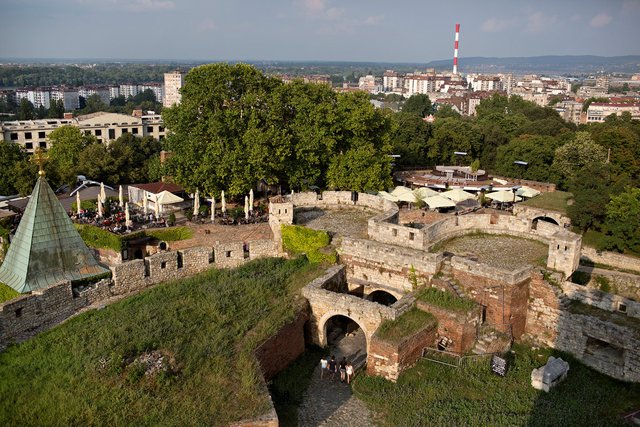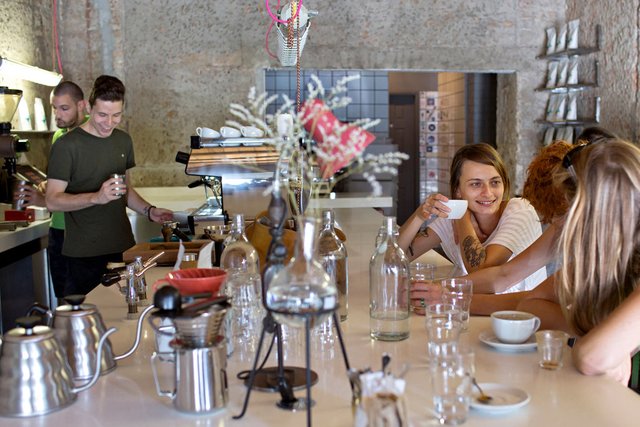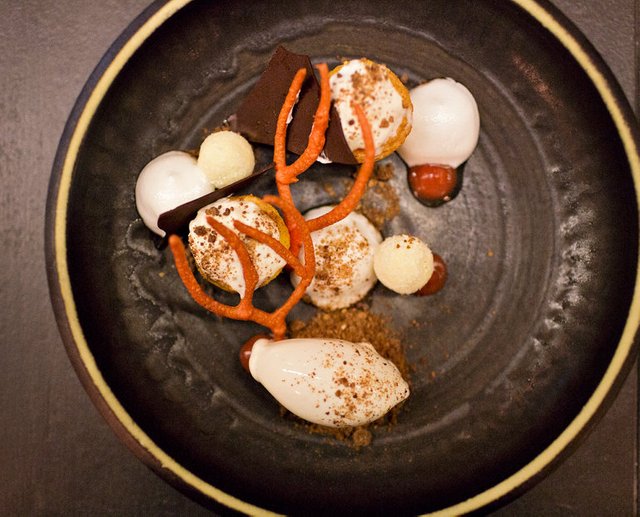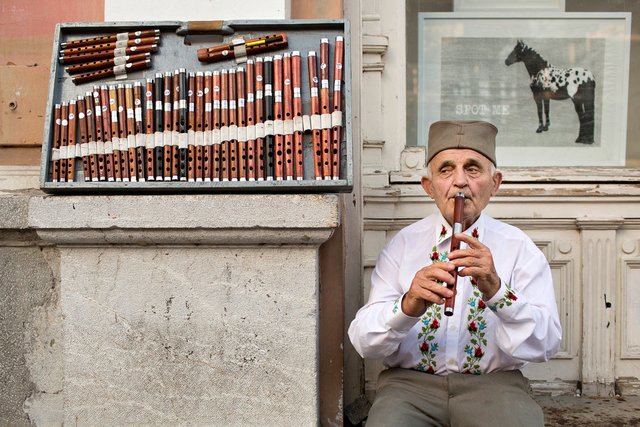
Is Belgrade the next Berlin? A stony gray city with battered trams and gritty charm, the Serbian capital sometimes looks like an Eastern European cousin of the German metropolis. Throw in Belgrade’s cafe scene, low prices, talented young designers, emerging former industrial districts, sausage-filled cuisine and unbridled night life — from D.J. bars to party boats to all-hours nightclubs — and the comparison seems even more compelling. And while it might lack the world-class cultural institutions of Berlin, Belgrade, at the confluence of the Sava and Danube rivers, offers its own distinctive appeal, withstorybook historical districts and venerable fortresses and parks. Better still, this center of Slavic cool just got much easier to reach:Direct flights from North America, via New York City, started in June on Air Serbia
Friday
1.THE BLUE DANUBE, 4 P.M.
Kalemegdan Park is Belgrade’s birthplace. Filling much of the promontory where the Danube and Sava Rivers converge, the green sprawl was settled millenniums ago by the Celts and bears traces of many successive peoples and empires. For views and history, enter at the north end of Knez Mihailova Street and head left. Along the clockwise circuit, crenelated stone lookout points offer views of the Sava and the waterside party rafts that flare to life at night — notablyHot Mess (with its own swimming pool) and 20/44 (a retro clubhouse of electro music) — before the path leads into an old citadel, built mostly in the 18th century. The grassy grounds contain a Roman well, 18th-century Austrian clock tower, Ottoman mausoleum, 19th-century Slavic half-timbered mansion and a military museum surrounded by old tanks and artillery: an almost-full retrospective of Serbia’s past.
2.ART AND COMMERCE, 6 P.M.
Everything you want to buy is for sale along Knez Mihailova. Lined with bookshops, souvenir emporiums, clothing chains and newspaper kiosks, the teeming pedestrian thoroughfare is also a forum for amateur artists, street musicians and that guy who makes enormous soap bubbles. Look up, too, because the ornate facades of the many 19th- and early-20th-century buildings form a textbook of architectural styles, including neo-Classical, Neo-Renaissance and Romantic. The Secessionist building at No. 42, built in the 1920s as a bank, was converted several years ago into the Zepter Museum, a vault of 20th-century and contemporary art. The tortured male forms in Vladimir Velickovic’s canvases show his debt to Francis Bacon, while the tilted perspectives and angles of Dragana Stanacev’s drawings induce vertigo. Abstract styles also abound, from the queasy color sloshes of Slobodan Trajkovic’s paintings to the thick, earthy layers of paint on Vera Bozickovic Popovic’s 1960s and 1970s works.

3.FACTORY MEETS FARMHOUSE, 9 P.M.
Grandma would be proud. Upstart Belgrade restaurateurs are championing the Balkan cuisine of their elders, infusing it with 21st-century ingredients and artistry. Witness Ambar, one of many chic restaurant-bars in the Beton Hala development along the Sava River. Inside and outside the soaring industrial space — with old-school touches like half-timbered walls and a wood-plank ceiling — young professionals indulge in pre-clubbing dinners that might start with kaymak (a soft, buttery cheese) flavored with hazelnut and porcini mushrooms; bacon-wrapped prunes from central Serbia; or grilled lamb skewers with sesame seeds and eggplant aioli. After, grilled meats satisfy traditionalists, while mains like salty-crisp duck with sweet beet salsa and pea purée hit contemporary notes. Balkan wines, including a dark-berry Serbian Prokupac red, accompany it all. A three-course dinner for two, without drinks, is about 4,500 dinars (about $40).
4.UNDER THE BRIDGE, 11 P.M.
By day, the gentrifying Savamala district under the Brankov Bridge beckons with art galleries, new wave barbershops and cultural centers like Mikser House, a former industrial space with products by Serbian designers. Come evening, the bar scene features spots likeBen Akiba, a sultry, red, candlelit bohemian bar with vintage furniture and a drinks list that encompasses everything from Brooklyn Lager (480 dinars) to Tetka Bosiljka (absinthe, apple liqueur, Passoa, basil and apple juice; 550 dinars). Deli 57 is a tiny,minimalist-modern bagel, sandwich and burger joint that at night becomes a packed, D.J.-fueled dance party. Serbian indie brewing provides the buzz, including spicy Supernova IPA by Kabinet (390 dinars).

Saturday
5.COFFEE CRAWL, 10 A.M.
Caffeine is Belgrade’s fuel, and the coolest filling stations have popped up in the emerging district of lower Dorcol. Take a seat inAviator’s ersatz natural world — potted plants, baskets of fruit, jungle-green banquettes — and survey the extensive coffee menu, which offers preparation options that include AeroPress, Chemex, Moka and drip. Smaller and more industrial, Przionica D59B roasts its own beans and serves up lattes (200 dinars), espresso martinis (390 dinars) and more in a room of rough stone and wood planks.
6.PIG OUT, NOON
A faux farmhouse lurks among the concrete blocks of downtown Belgrade. Decorated with timber beams, wicker baskets and red-checkered tablecloths, Kafana Cubura (pronounced CHOO-boor-a) is an old-school restaurant where couples and families linger over copious meals and local beer. Beef abounds, but pigs top the food chain here. The crackly crisp skin of pork and beef sausages gives way to a smoky, juicy interior, while the pork filet is a robust slab of white meat. Baklava, a Balkan dessert staple inherited from Serbia’s former Ottoman rulers, is a plump, sticky and honey-soaked mound. Lunch for two, about 2,500 dinars.
7.LOCAL LABELS, 2 P.M.
What is this dusty, dismal, downbeat structure hidden in a charmless passageway just off noisy Makedonska Street? Surprise — it’sBelgrade Design District. Occupying a disused shopping center, the six-year-old initiative has filled the abandoned retail spaces with boutiques by independent Serbian designers. For women’s wear that’s black with a touch of “Blade Runner,” duck into Imi, the store of the designer Ivana Ristic. More colorful and retro, the work ofVesna Kracanovic — for sale at her Modle boutique — includes long-sleeved vests with folkloric striped embroidery, sparkling pink pleated skirts with a 1940s touch and other retro-modern mash-ups.
8.HOUSE OF SPIRITS, 4 P.M.
The ghost of Josip Broz Tito, founder and leader of Yugoslavia for decades until his death in 1980, pervades the Museum of Yugoslav History. (Take the No. 41 bus from the southwest side of Studentska Square. Fare is 150 dinars.) There he is in the cinema’s sentimental biographical film, shaving in the morning, smoking cigars and meeting with foreign dignitaries from Jimmy Carter to Fidel Castro. There he is again on the mugs, plates, posters, medals and books in the gift shop. And there again, in his final resting spot, under a vast marble gravestone in the so-called House of Flowers. The former winter garden also displays the late dictator’s personal effects. Museum admission is 400 dinars, which includes compelling temporary exhibitions.

9.HOMA SWEET HOME, 8 P.M.
Serbian language lesson: sladoled. It means ice cream, and it suffuses the menu at Homa, a white haute-cuisine temple with soaring glass windows and a pleasant patio. A distinctive Parmesan-flavored ice cream accompanies a salad of compressed strawberries, peppercorn, pickled cucumber and lemon dressing that hits every taste bud. You’ll find peach ice cream alongside a duck leg with Jerusalem artichoke confit. Rose-flavored ice cream lends a Mideast aroma to cake discs and dark chocolate shards. A three-course meal for two, without wine, runs about 6,000 dinars. Reserve.
10.PARALLEL PARTIES, 11 P.M.
Past or present? The choice looms at the top of the street called Dzordza Vasingtona — a.k.a. George Washington. Take the street called Skadarska, and you’ll discover a cobbled, tree-shaded pedestrian path lined with wrought-iron streetlamps and Belgrade’s oldest restaurants. The wooden porch of Kaldrma Bar is a pleasant perch for sipping the house cocktail (vodka, gin, triple sec, lemon juice, Red Bull; 495 dinars) while listening to Balkan folk bands that work the street. The ambience changes if you take the street called Cetinjska, where a former brewing complex now pulses with Belgrade’s newest and noisiest night-life spots. Polet is a stone-walled haven of vintage furniture, artwork and quirky tunes (including ragtime and drum ‘n’ bass) where you can quaff Jelen beer (190 dinars) amid the academics, aging cool cats and thrift-store divas.

Sunday11.A PARTING GLANCE, NOON
The city’s prettiest historical district, Zemun, is perfect for a Sunday stroll. Spires of Baroque and 19th-century churches cast shadows on flower-lined cobbled streets lined with sherbet-hued houses, art galleries, craft workshops, riverbank cafes and fish restaurants. The 19th-century Gardos Tower, a.k.a. the Millennium Tower, lords over the landscape from the hilltop, offering 360-degree views from its circular balcony. (Admission, 200 dinars.) Over the sea of orange-tile roofs, the view opens onto the Danube and Sava Rivers and the distant skyline of central Belgrade and Kalemegdan Park, where your journey bega.
- L
- Steps from the city’s main pedestrian boulevard and Kalemegdan Park, the stylish 45-room Square Nine Hotel Belgrade (Studentski Trg 9; 381-11-333-3500; squarenine.rs) is outfitted with midcentury Danish and American furniture and has multiple restaurants, a rooftop bar and a spa. Doubles from 180 euros (about $200). Opened in 2014, the slick and contemporary Argo (Kralja Milana 25; 381-11-364-0425; argohotelbelgrade.com) is in the southern part of the city center, near the train station and St. Sava Temple. The 20 rooms are done in a palette of cream, brown and pistachio. Doubles from €59 (low season) or €75 (high).
@lapa Loved your post! Very beautiful photos. :)
Downvoting a post can decrease pending rewards and make it less visible. Common reasons:
Submit
Thanks
Downvoting a post can decrease pending rewards and make it less visible. Common reasons:
Submit